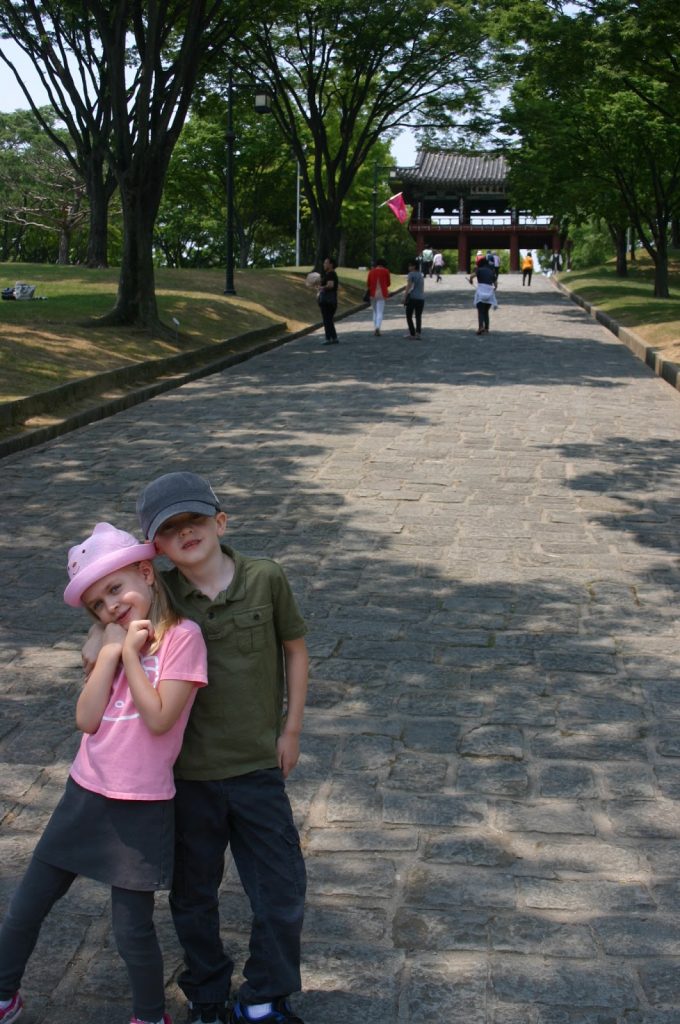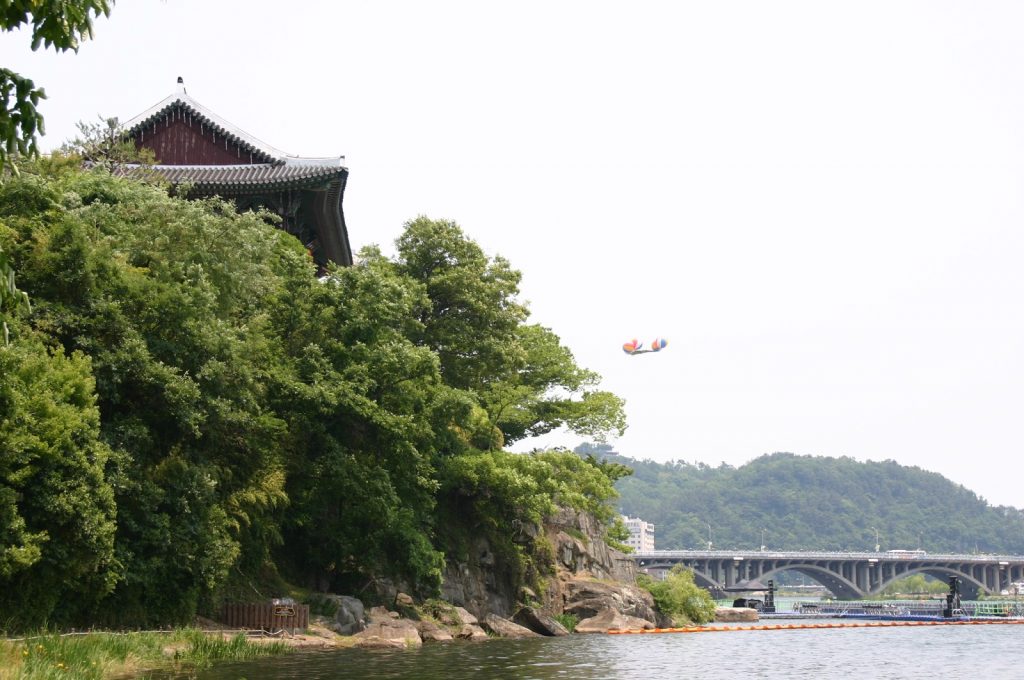Every May, the city of Jinju celebrates the Nongae Festival at Jinju Fortress (Jinjuseong). It is a traditional arts festival that “presents the spirit of Jinju and the loyal spirit of patriotic Nongae.”


Who is Nongae? She was, like most Korean historical figures, a complete and total bada**.
Do you remember, in my post about Seollal, I posted a picture of a statue in Jinjuseong of General Kim Si-Min? Without much detail, I mentioned that in 1592 he and an army of 3800 men held Jinjuseong against a Japanese invading force of 20,000. And in my post about April, I mentioned Admiral Yi Sun-Sin and his turtle boats defeating a (much larger) Japanese naval force at the Battle of Sacheon in 1592. Well, all of that was part of a larger conflict known as the Imjin War (or Imjinwaeran War, or the Japanese Invasions of Korea). I could (and may, if I have time) write an entire post about this war, simply because of the many bada** Korean leaders and fighters (warrior monks!) that appeared during it.
In the late 16th century, Toyotomi Hideyoshi* unified Japan and began looking toward Korea and China. In 1592, he invaded Korea with around 160,000 soldiers. They made a lot of progress across the peninsula, but became locked in a stalemate and declared a truce. When peace negotiations failed, the Japanese tried invading again in 1597, but ultimately failed to make further progress. Hideyoshi’s death in 1598, combined with the Korean navy interrupting their supply lines to Japan, led the Japanese to finally withdraw from the Korean peninsula and eventually resume normal relations.
During the initial invasion, Jinjuseong was targeted by the Japanese as a strategic stronghold that would allow them access to Jeolla province in the west (a rich, agricultural region of the peninsula). Some 20-30,000 Japanese soldiers were sent to take Jinjuseong in what was supposed to be an easy victory for the Japanese. But General Kim was a clever and well-prepared man who had the foresight to acquire a couple hundred arquebuses (an early hand gun) that helped the small Korean force repel the Japanese. It was one of the greatest Korean victories during the war.
Unfortunately, this rather pissed off Hideyoshi, who sent another force several months later with 90-120,000 soldiers determined to obliterate the Koreans. And obliterate they did. The few thousand Korean soldiers at Jinjuseong were killed, along with 50-70,000 Korean citizens.
To celebrate their victory, the Japanese gathered in Chokseongnu Pavilion in Jinjuseong and summoned all of the gisaeng to entertain them.


Gisaeng (another interesting subject that could consume an entire post) were basically government slaves who functioned as “entertainers.” This included everything from dancing and composing poetry to sexual services and even to medical care and diplomacy. Gisaeng occupied the lowest status in society, but because they were government employees, so to speak, they were also highly regulated and carefully trained. Many were accomplished poets and artists, though their talents went unappreciated because of their low social status. Gisaeng lived throughout Korea, but most worked at the royal court in Seoul.
Nongae was one of these gisaeng. But she had other plans to “entertain” the Japanese soldiers. Putting on her finest dress and jewelry, the beautiful Nongae sat down upon a rock next to the Nam River underneath Chokseongnu. She began singing and playing a geomungo (Korean harp). Naturally, the Japanese were enthralled by her beauty and several went down to the rock, but only a Japanese general dared approached her. Nongae smiled and flirted with the general, then invited him to dance. Nongae embraced the general tightly, used rings on her fingers to lock her hands together, and threw herself off the rock into the river. Unable to escape her grasp, the Japanese general drowned along with Nongae.

Throughout the years, Nongae has been celebrated by various Korean authors and historians for her patriotism and loyalty. The rock from which she jumped is known as Uiam (“righteous rock”) and her spirit is honored in Jinjuseong at Uigisa (“righteous gisaeng shrine”), apparently the only shrine in Korea dedicated to a woman. Her rings, a symbol of her loyalty, adorn the Jinju Bridge that crosses Nam River. The city has long held a festival honoring Nongae’s spirit, but they began the Nongae Festival of arts in 2002.

The festival is held over three days the last weekend in May. It began with the ritual honoring Nongae’s spirit – “Uiambyeolje” – superintended by women and involving song and dance. A variety of other songs and dances were performed throughout the festival, as well. There were booths showcasing traditional foods and drink, pottery, wood chopping, books and writing utensils. We tried some traditional Korean rice tea, and puffed rice with some kind of ginger toffee. There were commercial booths selling Jinju strawberry jam, Jinju silk (the city produces 70-80% of Korea’s silk), and other local specialties. We bought a delicious pineapple smoothie from Buddhist nuns. We got ice cream and watched part of a traditional “intercultural” wedding (the groom was Dutch, I think). There were booths devoted to traditional clothes, as well: one to choose your hanbok and one to have your hair and makeup professionally done. Groups of beautiful Korean ladies in hanbok sat on the grass underneath the trees, surfing the web on their smart phones. There were pony rides, archery games, strolling drum bands, a place where kids could draw Nongae on a leaf and hang it on a “tree”… and several other booths that were not yet set up when we were there (we left before the party really started). And all of this was just in the fortress. Across the river was an even bigger party and we could see an entire street full of booths, plus a temporary dock on the river with boats and jet skis for rent.











The highlight of the festival every year, which unfortunately we missed, is a nighttime reenactment of Nongae’s sacrifice. The audience sits on a pontoon platform floating on the river and watches actors reenact the battle, the rock encounter, and Nongae grabbing the general before leaping into the water. As you can imagine, the sight of actors fully clad in traditional clothes leaping into the water in a display of patriotic loyalty is rather popular with the crowd. I hope we can see the reenactment, if we return next year.
*Toyotomi Hideyoshi is remembered by the Japanese for a number of achievements, and by non-Japanese for a number of atrocities. I’m sure you can guess what Koreans think of him. A million Koreans died during the Imjin War (one-third of their population at the time). And there is quite literally an ear (and nose) mound in Kyoto known as Mimizuka (“ear mound”), a monument dedicated to the war trophies Hideyoshi sent back to Japan: the ears and noses of tens of thousands of Korean citizens. Such “trophy” mounds from the war are actually found in several places throughout southern Japan. Mimizuka has been a point of contention between Korea and Japan, especially in the late 20th century, when Japanese educators refused to include the site in history textbooks – and when they finally did, tried to argue that it was a monument to the spirits of the Koreans who were killed. A Times article written in 1997 on the 400th anniversary of Mimizuka’s dedication stated that few Japanese knew about the monument’s existence, and yet nearly all Koreans did. … And if you watched Martin Scorsese’s depress-fest Silence last year, you may be familiar with the persecution of Christians in early 17th century Japan. Hideyoshi got that ball rolling when he crucified 26 Franciscan missionaries and Japanese Catholics in Nagasaki in 1597. The imperial government – which initially welcomed St. Francis Xavier as a possible bridge to European trade and Catholic missionaries as a counterbalance to powerful Buddhist monks – became fearful that Christianity was a precursor to colonialism (as it had been elsewhere), so outlawed the foreign religion. Over the next few decades, hundreds of Japanese and missionary Christians were killed and those who remained became the Kakure Kirishitan, “hidden Christians,” worshiping in secret until the religious ban was lifted in 1873. Western missionaries who arrived in the late 19th century were shocked to discover around 30,000 Kakure Kirishitan in Japan at the time.



